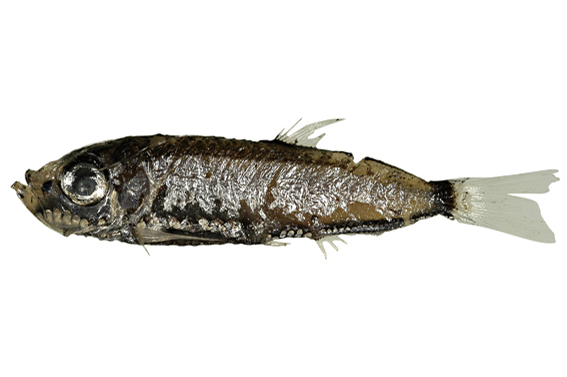Pennant Pearlside, Maurolicus australis Hector 1875
Other Names: Pennant Lantern-fish

Pennant Pearlside, Maurolicus australis. Source: Australian National Fish Collection, CSIRO. License: CC BY Attribution-Noncommercial
Summary:
A pearlside with a black dorsal surface, bright silvery sides, silvery light organs outlined in black, and clear fins except for the two anterior dorsal-fin rays. The photophores along the ventral surface have a distinct pink hue in freshly caught fish. The stomach and rear part of the intestine are intensely pigmented (black), the inner surface of the gill arches is dark brown, and there are dark spots on the gill rakers.
Cite this page as:
Bray, D.J. 2025, Maurolicus australis in Fishes of Australia, accessed 27 Jun 2025, https://fishesofaustralia.net.au/Home/species/3943
Pennant Pearlside, Maurolicus australis Hector 1875
More Info
|
Distribution |
Off Crowdy Head, New South Wales, to west of Exmouth, Western Australia, including around Tasmania. Elsewhere the species occurs in the south-west Pacific (Kermadec Islands to off New Zealand). Inhabits epipelagic and mesopelagic waters, most commonly at depths of 150-400 m. Individuals undertake diel vertical migrations to feed in shallower waters at night. |
|
Features |
Dorsal fin 10-12; adipose; Anal fin 21-24; Pectoral fin 17-18; Pelvic fin 7; Caudal fin 17; Gill rakers 27-32; Vertebrae 33-34; AC photophores 22-25. Body depth 22–25% SL; head length 29–31% SL; eye diameter 10–12% SL |
|
Size |
|
|
Feeding |
Feeds mostly on copepods. |
|
Biology |
Spawns during late winter to spring. |
|
Fisheries |
Some species of Maurolicus form large schools, and are important species in pelagic food chains. They are preyed upon by a range of fishes, squid and cetaceans. |
|
Remarks |
In Australia, this species has been confused with Maurolicus muelleri, which occurs in the Atlantic Ocean. |
|
Etymology |
The specific name is from the Latin australis (= southern), in reference to the type locality of New Zealand. Hector called it the "Southern Pearlside". |
|
Species Citation |
Maurolicus australis Hector 1875, Transactions and Proceedings of the New Zealand Institute 7(34): 250, Pl. 11 (fig. 90d). Type locality: Milford Sound and Cuttle Cave in Preservation Inlet, New Zealand. |
|
Author |
Bray, D.J. 2025 |
|
Resources |
Australian Faunal Directory |
Pennant Pearlside, Maurolicus australis Hector 1875
References
Allen, G.R., Hoese, D.F., Paxton, J.R., Randall, J.E., Russell, B.C., Starck, W.A., Talbot, F.H. & Whitley, G.P. 1976. Annotated checklist of the fishes of Lord Howe Island. Records of the Australian Museum 30(15): 365-454 figs 1-2
Bulman, C.M., Condie, S.A., F.J. Neira, F.J., et al. 2011. The trophodynamics of small pelagic fishes in the southern Australian ecosystem and the implications for ecosystem modelling of southern temperate fisheries. CSIRO Marine and Atmospheric Research Final report for FRDC project 2008/023, 110 pp.
Clarke, T.A. 1982. Distribution, growth, and reproduction of the lightfish Maurolicus muelleri (Sternoptychidae) off south-east Australia. Cronulla, N.S.W. : Commonwealth Scientific and Industrial Research Organization, Marine Laboratories, 10 pp. (misidentified as Maurolicus muelleri)
Flynn, A.J. & Pogonoski, J. 2012. Guide to mesopelagic fishes of the southern Tasman Sea. Hobart, Australia : CSIRO Marine and Atmospheric Research i-v + 221 pp.
Harold, A.S. 1999. Families Gonostomatidae, Sternoptychidae, Phosichthyidae, Astronesthidae, Stomiidae, Chauliodontidae, Melanostomiidae, Idiacanthidae, Malacosteidae. pp. 1896-1917 in Carpenter, K.E. & Niem, V.H. (eds). The Living Marine Resources of the Western Central Pacific. FAO Species Identification Guide for Fisheries Purposes. Rome : FAO Vol. 3 pp. 1397-2068.
Harold, A. 2020. Maurolicus australis. The IUCN Red List of Threatened Species 2020: e.T137568775A137570749. https://dx.doi.org/10.2305/IUCN.UK.2020-1.RLTS.T137568775A137570749.en. Accessed on 25 March 2025.
Harold, A.S., Stewart, A.L. & Roberts, C.D. 2015. Family Sternoptychidae. pp. 446-468 in Roberts, C.D., Stewart, A.L. & Struthers, C.D. The Fishes of New Zealand. Wellington : Te Papa Press Vol. 2 pp. 1-576.
Harold, A.S. & Gomon, M.F. 2008. Various family accounts. pp. 225 in Gomon, M.F., Bray, D.J. & Kuiter, R.H. (eds). Fishes of Australia's Southern Coast. Sydney : Reed New Holland 928 pp.
Hector, J. 1875. Notes on New Zealand ichthyology. Transactions and Proceedings of the New Zealand Institute 7(34): 239-250 pls 10-11 See ref at BHL
McCulloch, A.R. 1923. Fishes from Australia and Lord Howe Island. No. 2. Records of the Australian Museum 14(2): 113–125. https://doi.org/10.3853/j.0067-1975.14.1923.833 (as Maurolicus pennanti australis)
Parin, N.V. & Kobyliansky, S.G. 1993. Review of the genus Maurolicus (Sternoptychidae, Stomiiformes), with re-establishing validity of five species considered junior synonyms of M. muelleri and descriptions of nine new species. Transactions. P. P. Shirshov Institute of Oceanology 128: 69-107
Parin, N.V. & Kobyliansky, S.G. 1996. Diagnoses and distribution of fifteen species recognized in genus Maurolicus Cocco (Sternoptychidae, Stomiiformes) with a key to their identification. Cybium 20(2): 185-195.
Rees, D.J., Byrkjedal, I. & Sutton, T.T. 2017. Pruning the Pearlsides: Reconciling morphology and molecules in mesopelagic fishes (Maurolicus: Sternoptychidae), Deep Sea Research Part II: Topical Studies in Oceanography 137: 246-257, ISSN 0967-0645, https://doi.org/10.1016/j.dsr2.2016.04.024.
Rees, D.J., Poulsen, J.Y., Sutton, T.T. et al. 2020. Global phylogeography suggests extensive eucosmopolitanism in Mesopelagic Fishes (Maurolicus: Sternoptychidae). Scientific Reports 10: 20544. https://doi.org/10.1038/s41598-020-77528-7
Robertson, D.A. 1976. Planktonic stages of Maurolicus muelleri (Teleostei Sternoptychidae) in New Zealand waters, New Zealand Journal of Marine and Freshwater Research 10(2): 311-328, https://doi.org/10.1080/00288330.1976.9515615 (as Maurolicus muelleri)

